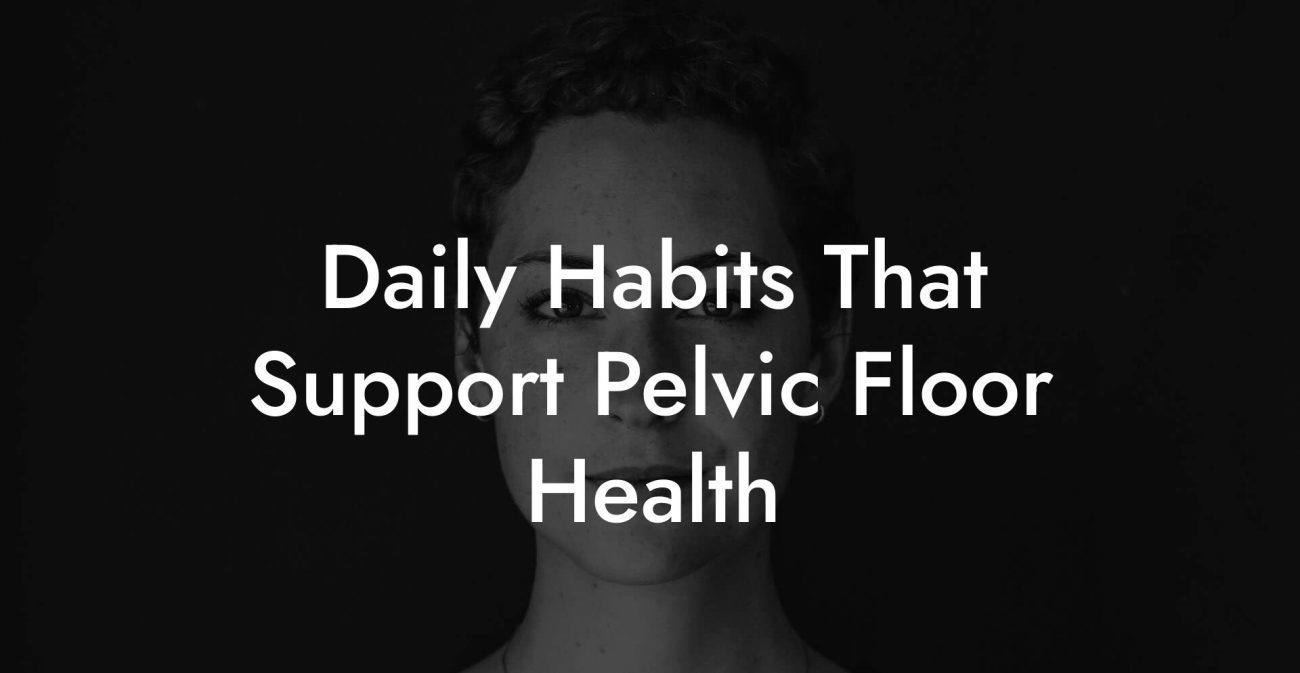
Pelvic Floor Therapy
How the Pelvic Floor Impacts Men’s Health

Ever felt like you’ve been running on low battery even though you’re doing everything “right”? What if we told you that the secret to unlocking peak performance, both physically and mentally, might lie in one unsung hero: your pelvic floor? Many men never give a second thought to that deep, inner muscle group, but it’s a powerhouse that significantly impacts your core strength, sexual performance, stress management, and even your posture. This deep-dive guide into “How the Pelvic Floor Impacts Men’s Health” is here to break down the science, bust some myths, and serve up actionable tips in a fun, no-nonsense style that resonates with the Gen-Z and millennial crowd.
Quick Links to Useful Sections
- Understanding the Male Pelvic Floor: Anatomy, Function, and Importance
- The Hidden Connection: How the Pelvic Floor Impacts Men’s Overall Health
- Recognizing Pelvic Floor Dysfunction in Men
- Empowering Your Core: Pelvic Floor Exercises and Techniques for Men
- Integrative Approaches to Pelvic Floor Therapy for Men
- Lifestyle, Nutrition, and the Mind: Holistic Strategies for Men’s Pelvic Health
- Technological Innovations and Modern Approaches in Pelvic Floor Therapy
- Real Stories: Transformations in Men’s Pelvic Health
- Resources and Community Support: Your Next Steps
- Integrative and Holistic Approaches FAQs: Your Questions Answered
- Your Journey to Empowered, Holistic Pelvic Health
Understanding the Male Pelvic Floor: Anatomy, Function, and Importance
When you think of your core muscles, the abs and obliques might immediately come to mind. However, the pelvic floor, a complex network of muscles, ligaments, and connective tissues, plays a foundational role in stabilizing your core. Nestled at the base of your pelvis, this muscle group not only supports the organs in your pelvic region but also influences your posture, balance, and even your breathing patterns.
Anatomically speaking, the male pelvic floor consists of several muscles, including the levator ani, coccygeus, and the deep transverse perineal muscles. Together, they form a supportive hammock that maintains the position of your bladder, bowel, and sexual organs. Think of these muscles as the unsung heroes behind your power moves, whether that's sprinting on the field or even acing a presentation at work.
Functionally, a strong pelvic floor contributes to improved bladder and bowel control, enhanced sexual performance, and reduced risk of chronic lower back pain. In short, nurturing this muscle group isn’t just about preventing embarrassing leaks, it’s about investing in your overall strength, vitality, and quality of life. When these muscles work harmoniously with other core muscles, the results are a more resilient body that can handle the everyday stresses and strains of modern life.
For many men, understanding this invisible powerhouse is the first step to unlocking newfound energy and improved physical health. And while it may seem like a domain reserved for postnatal women, emerging research and expert insights confirm that pelvic floor health is equally crucial for men. So, buckle up as we delve into the many ways your pelvic floor can influence everything from your sports performance to your stress resilience.
Your pelvic floor affects how you move, how you use the bathroom, and how sex feels, yet most men are never taught how it works. This essential guide explains your pelvic floor in plain language and gives you a simple plan to relax, strengthen, and look after it at home.
Youll Learn How To:
- Understand what your pelvic floor does for bladder control, posture, and sex
- Spot signs of tension, weakness, and poor coordination
- Use breathing, reverse Kegels, and classic Kegels safely
- Improve habits for sitting, lifting, sport, sleep, and stress
Whats Inside: friendly explanations, safety guidelines, daily drills, sex function tools, flare up plans, and a complete twelve week program with trackers.
Perfect For: men of all ages who want less pelvic tension, fewer leaks, better comfort on the toilet, and more confidence in movement and in the bedroom.
The Hidden Connection: How the Pelvic Floor Impacts Men’s Overall Health
Let’s cut to the chase: your pelvic floor is way more than a bundle of muscles tucked away at the base of your pelvis. It’s a critical player in your everyday health, influencing a myriad of physical and even mental functions. When the pelvic floor is in top shape, you’re likely to experience improved stability, enhanced sexual function, and better control over bodily functions, a trifecta of benefits that many modern men are eager to embrace.
Consider these key areas where the pelvic floor exerts its influence:
- Core Stability and Posture: A robust pelvic floor works as a solid base for all the muscles above it. This supportive foundation enables your core to function optimally, reducing the risk of injury during physical activities and easing chronic lower back tension.
- Sexual Health and Performance: A well-conditioned pelvic floor not only boosts blood flow and nerve sensitivity but also contributes to better erectile function and enhanced sexual endurance. In essence, it can improve your “game in the sheets” while also adding to your overall confidence.
- Urinary and Bowel Control: Effective control over your pelvic floor muscles means better management of urinary frequency and incontinence, which are common concerns as men age or after certain medical procedures.
- Stress Resilience: There’s a fascinating connection between physical tension and mental stress. A weakened pelvic floor can contribute to a cycle of chronic tension that exacerbates anxiety and stress. By strengthening these muscles, you may also find it easier to relax and manage everyday stressors.
When it comes to men’s health, nurturing your pelvic floor transcends the conventional gym routine. It taps into a more integrative approach to wellness, one that considers not just your physical form but your mental and emotional resilience, too.
In a world where long hours at the desk, high-intensity workouts, and relentless digital connectivity are the norms, a strong and balanced pelvic floor offers a counterbalance, a grounding force that helps you navigate everyday challenges with renewed strength and vigor.
Recognizing Pelvic Floor Dysfunction in Men
Pelvic floor dysfunction in men might not be talked about at dinner parties, but it’s a real issue that can impact your comfort and quality of life. The symptoms can range from urinary leakage and chronic pelvic pain to sexual dysfunction and lower back discomfort. If you're experiencing any of these issues, it might be time to consider that your pelvic floor muscles need some attention.
One common culprit is prolonged sitting. Whether you’re glued to your office chair or binge-watching your favorite series, extended periods of sitting can lead to weakened pelvic muscles and even nerve compression. And let’s be real, if you’re a millennial or Gen-Z pro at multitasking, long hours of digital immersion may be making your pelvic floor pay the price.
Other factors include:
- Overtraining: Excessive or improper exercise can strain your pelvic muscles, leading to imbalances.
- Injury or Surgery: Trauma or surgeries involving the pelvic region can compromise muscle function if not properly rehabilitated.
- Posture Issues: Poor posture, often exacerbated by our modern sedentary lifestyles, can put undue pressure on the pelvic floor.
- Stress and Anxiety: Chronic stress is a silent saboteur, causing muscle tension that can extend to the pelvic area.
Recognizing the signs early on is key to preventing further deterioration. If you notice any issues such as the need to “rush” to the bathroom, penile discomfort, or inexplicable lower back pain, consider scheduling an evaluation with a pelvic health specialist. Early intervention can lead to targeted therapies that restore strength, flexibility, and function.
It’s important to understand that pelvic floor dysfunction isn’t solely a byproduct of aging; it’s a complex issue that can affect men at various stages of life. Today’s active lifestyle demands a proactive approach to health, and tending to your pelvic floor is an essential part of that strategy.
As we break down these barriers of silence and stigma, remember that taking charge of your pelvic health is an act of self-respect and empowerment. It’s time to bring this under-discussed topic into the spotlight and reclaim control over your body, and your life.
Your pelvic floor affects how you move, how you use the bathroom, and how sex feels, yet most men are never taught how it works. This essential guide explains your pelvic floor in plain language and gives you a simple plan to relax, strengthen, and look after it at home.
Youll Learn How To:
- Understand what your pelvic floor does for bladder control, posture, and sex
- Spot signs of tension, weakness, and poor coordination
- Use breathing, reverse Kegels, and classic Kegels safely
- Improve habits for sitting, lifting, sport, sleep, and stress
Whats Inside: friendly explanations, safety guidelines, daily drills, sex function tools, flare up plans, and a complete twelve week program with trackers.
Perfect For: men of all ages who want less pelvic tension, fewer leaks, better comfort on the toilet, and more confidence in movement and in the bedroom.
Empowering Your Core: Pelvic Floor Exercises and Techniques for Men
If you’ve ever been told to “tighten up” during a workout, you might be closer to what you need than you think. Pelvic floor exercises for men are a game-changer when it comes to boosting your core strength and overall vitality. And no, it’s not just about doing Kegels, there’s an entire repertoire of exercises designed to target and strengthen these essential muscles.
One of the most accessible exercises is the classic Kegel. To do a Kegel, contract the muscles you would use to stop urinating mid-stream, hold for several seconds, and release. Regular practice helps to not only improve bladder and bowel control but also enhances sexual performance by promoting better blood flow and nerve sensitivity.
However, the world of pelvic floor exercises extends much further. Here are some techniques to consider:
- Reverse Kegels: While Kegels involve tightening, reverse Kegels focus on controlled relaxation. Mastering both contraction and relaxation phases can help you achieve a well-balanced pelvic floor.
- Core Integration Workouts: Incorporate exercises like planks, bridges, and pelvic tilts into your routine. These moves engage not just your abs but also the deeper pelvic muscles, providing a more holistic workout.
- Dynamic Movements: Exercises such as squats and lunges, when performed correctly, can also stimulate the pelvic floor. It’s all about coordinating movement and breathing to maximize muscle engagement.
- Yoga and Pilates: Both practices emphasize controlled movements and mindful breathing. Specific poses, like the bridge pose or seated forward fold, can enhance pelvic floor strength while promoting relaxation.
The key to success is consistency. Incorporate these exercises into your daily routine, whether you’re at home, at the gym, or even taking a work break. There’s no “one size fits all” here. Just like your favorite playlist, customize your exercise mix to reflect your personal goals, fitness level, and lifestyle.
Remember, these techniques not only lessen the risk of dysfunction but also enhance your overall performance, from sports and fitness to daily activities. Over time, you’ll likely notice improved posture, reduced muscle tension, and an overall boost in confidence. So, whether you’re looking to step up your game in the bedroom or nail that marathon, strengthening your pelvic floor is a power move you simply can’t afford to ignore.
For those new to pelvic floor exercises, consider consulting a pelvic health specialist or physical therapist who can guide you through proper techniques. With the right practice and a bit of discipline, you’ll soon be harnessing the true power of your inner core.
Integrative Approaches to Pelvic Floor Therapy for Men
Let’s be honest, traditional gym routines and isolated exercises can sometimes feel like they’re missing the bigger picture. That’s where integrative pelvic floor therapy comes into play. By coupling conventional methods with complementary therapies, you can achieve a more holistic improvement in your pelvic floor health.
This integrative approach isn’t just about repeating the same movements day after day; it’s about acknowledging that your pelvic health is intertwined with every aspect of your life. From nutrition and mental wellness to advanced physical therapy techniques, each element plays an integral role in your overall recovery and performance.
Here’s how you can implement an integrative approach tailored for the modern man:
- Conventional Therapy Plus: Begin with a structured pelvic floor exercise regimen guided by a physical therapist. Learn the proper techniques for Kegels, reverse Kegels, and core stabilization exercises.
- Mind-Body Techniques: Adopt mindfulness meditation and deep breathing exercises to ease the tension that often exacerbates pelvic dysfunction. Try syncing your breathing with your muscle contractions to foster a deeper mind-body connection.
- Complementary Therapies: Explore alternatives such as acupuncture, which has been shown to alleviate chronic pain and induce relaxation. For those who are tactile learners, regular sessions with a massage therapist can help release built-up tension in neglected areas.
- Nutritional Adjustments: A diet rich in anti-inflammatory foods like leafy greens, berries, lean proteins, and healthy fats can encourage muscle repair and reduce chronic inflammation. Hydration is also a crucial aspect; make sure you’re drinking enough water throughout the day to keep tissues supple.
- Lifestyle Tweaks: Prioritize sleep, manage stress through hobbies or creative outlets, and remind yourself to move more often, especially if your work confines you to a desk for long hours.
The beauty of this integrative plan is that it evolves with you. As you notice improvements in one area, you might find that other aspects of your health, like your energy levels, focus, and mood, improve as well. It’s a holistic cycle of reinforcement that goes beyond simple muscle training.
Your pelvic floor affects how you move, how you use the bathroom, and how sex feels, yet most men are never taught how it works. This essential guide explains your pelvic floor in plain language and gives you a simple plan to relax, strengthen, and look after it at home.
Youll Learn How To:
- Understand what your pelvic floor does for bladder control, posture, and sex
- Spot signs of tension, weakness, and poor coordination
- Use breathing, reverse Kegels, and classic Kegels safely
- Improve habits for sitting, lifting, sport, sleep, and stress
Whats Inside: friendly explanations, safety guidelines, daily drills, sex function tools, flare up plans, and a complete twelve week program with trackers.
Perfect For: men of all ages who want less pelvic tension, fewer leaks, better comfort on the toilet, and more confidence in movement and in the bedroom.
For instance, while specialized pelvic floor exercises may be your starting line, the additional benefits of stress reduction and nutritional support may help prevent the recurrence of dysfunctions. In today’s fast-paced world, where balancing work, family, and self-care can feel overwhelming, an integrative approach offers a roadmap to reclaim resilience and vitality.
Embrace this multi-faceted approach as part of your lifestyle, and you’ll soon see that the benefits reach far beyond just a stronger pelvic floor, they can transform your overall well-being.
Lifestyle, Nutrition, and the Mind: Holistic Strategies for Men’s Pelvic Health
It might sound cliché to say “you are what you eat,” but when it comes to pelvic floor health, this axiom rings true. Your diet, daily habits, and even how you manage stress have a direct bearing on the strength and flexibility of your pelvic muscles. For the modern man, blending nutritional savvy with mindfulness techniques is not just smart, it’s essential.
Start with small but impactful changes: swap out processed snacks for nutrient-rich alternatives like nuts, fruits, and vegetables. Anti-inflammatory foods such as turmeric, ginger, and omega-3 rich fish are particularly beneficial for reducing chronic inflammation that can impair muscle function. Staying hydrated and maintaining a balanced diet fuels the repair and growth of your muscle fibers, setting a solid foundation for pelvic health.
Sleep and stress management are other indispensable pillars of a holistic lifestyle. Modern life can be a relentless stress-fest, but carving out time for quality sleep, regular physical activity, and mindfulness practices, like meditation or even a quick walk outside, can make a world of difference. When your mind is calm, your body responds by releasing tension, including in the pelvic region.
Engaging in hobbies, social activities, or creative outlets also contributes to a well-rounded sense of well-being. Whether you’re jamming with friends, exploring new experiences, or unwinding with a favorite series, these moments of joy reduce cortisol levels and promote relaxation, which in turn benefits your muscle tone and recovery.
Lastly, integrating holistic strategies into your daily routine isn’t about perfection, it’s about progress. Even small adjustments, over time, can lead to significant improvements in pelvic function and overall quality of life. In today’s fast-paced society, evolving into a version of yourself that values both physical prowess and mental clarity is a statement of self-respect and resilience.
Technological Innovations and Modern Approaches in Pelvic Floor Therapy
Technology isn’t just revolutionizing social media and entertainment, it’s also transforming how we approach health and wellness. For men interested in optimizing their pelvic health, a new wave of gadgets and apps is making it easier than ever to monitor progress and enhance your exercise routines.
Biofeedback devices, for instance, are designed to give you real-time insights into your pelvic muscle activity. These gadgets work by providing visual or auditory feedback during your exercises, ensuring that you’re engaging the right muscles with precision. This high-tech approach not only accelerates your learning curve but also builds confidence as you see tangible progress.
Smartphone applications and wearable tech are also stepping into the spotlight. Many of these apps come with guided pelvic floor workouts, progress tracking, and reminders to help you stay consistent. For those who thrive on data, tracking your reps, hold times, and progress over time can be a potent motivator.
Additionally, virtual therapy sessions and online consultations with pelvic health specialists are gaining traction. These digital platforms make expert advice accessible to everyone, whether you’re a busy Gen-Z professional or a millennial juggling multiple roles. The future is digital, and your pelvic floor routine can seamlessly integrate into your high-tech lifestyle.
Modern approaches emphasize not just physical exercise, but also the importance of data-driven insights and personalized feedback. Embracing these innovations can empower you to make informed decisions about your health and tweak your routines for optimal results. In a world full of distractions and information overload, using technology to fine-tune your well-being is a practical and forward-thinking strategy.
Real Stories: Transformations in Men’s Pelvic Health
Sometimes, the most compelling evidence isn’t found in research papers but in real-life success stories. Men from diverse backgrounds have tapped into the power of pelvic floor therapy and integrative approaches, experiencing breakthroughs that have transformed both their physical and mental health.
Meet Alex, a 32-year-old fitness enthusiast who struggled with unexplained lower back pain and diminished athletic performance. After incorporating targeted pelvic floor exercises into his routine and complementing them with mindfulness techniques, Alex reported a significant reduction in pain and an unexpected boost in his workout performance. He now swears by the holistic integration of physical therapy with stress-reduction practices.
Then there’s Marcus, a 45-year-old executive who had been battling urinary incontinence, a topic that once filled him with embarrassment. With guidance from a pelvic health specialist, Marcus embarked on a customized plan that included conventional pelvic floor exercises, nutrition adjustments, and even the use of a biofeedback device. Over time, he regained control and confidence, and his journey inspired him to be more open about discussing men’s pelvic health.
And let’s not forget Darren, a 28-year-old creative professional, whose sedentary work life left him with chronic pelvic tension and occasional discomfort. Darren incorporated a mix of integrative therapies, including yoga, Pilates, and deep breathing exercises, into his daily routine. The results? A newfound ease in movement, improved posture, and a noticeable lift in his overall energy levels.
These narratives are not isolated incidents; they represent a growing awareness among men that pelvic floor health is central to overall wellness. They underscore the importance of breaking away from outdated stereotypes and being proactive about one’s health, irrespective of gender norms. Whether you’re a weekend warrior, a high-powered professional, or someone just starting your fitness journey, these stories serve as a testament to the transformative potential of a well-tuned pelvic floor.
As you read these accounts, consider the possibilities that await you. The journey to improved pelvic health is deeply personal but can also bring about profound transformations that echo into every facet of your life.
Resources and Community Support: Your Next Steps
Ready to take charge of your pelvic health? You’re not in this alone. There’s a thriving community of experts, online platforms, and interactive resources designed to guide you every step of the way. Whether you’re looking for professional advice, peer support, or simply more information on pelvic floor strengthening techniques, the resources available today make it easier than ever to get started.
Tap into reputable websites, forums, and social media groups that focus on men’s health and wellness. Engage with online communities where members share their challenges, successes, and practical tips to boost confidence and knowledge. Look for specialized clinics and pelvic health centers that offer tailored therapy sessions, many even provide virtual consultations, so you can get expert advice from the comfort of your home.
There are also a wealth of mobile apps dedicated to pelvic floor exercises and mindfulness routines, offering guided sessions, progress-tracking, and personalized reminders. These tools not only help you stay consistent with your exercises but also provide valuable feedback on your progress.
Finally, don’t underestimate the power of community events, webinars, and workshops. Many organizations run periodic sessions where you can learn from top pelvic health experts, ask questions, and connect with others on a similar journey. These holistic gatherings can offer fresh perspectives and inspire you to keep pushing forward.
Your next steps are clear: Educate yourself, experiment with different techniques, and embrace a well-rounded approach that aligns with your lifestyle. By integrating the best of technology, expert advice, and community support, you can develop a personalized plan that nurtures your body, sharpens your mind, and empowers you to live life at your fullest.
The pathway to optimal pelvic health is a journey of self-discovery, resilience, and continual growth. And every step you take toward understanding and strengthening your pelvic floor is a step toward a more dynamic, confident, and robust life.
Integrative and Holistic Approaches FAQs: Your Questions Answered
Here are some frequently asked questions that address common concerns about pelvic floor therapy and integrative approaches for men:
1. What role does the pelvic floor play in overall men’s health?
The pelvic floor supports core stability, aids in bladder and bowel control, enhances sexual function, and helps manage lower back pain. It’s a fundamental component of overall physical and mental wellness.
2. How can pelvic floor dysfunction affect daily life?
A weakened pelvic floor can lead to urinary incontinence, chronic pelvic pain, diminished sexual performance, and postural issues, all of which can adversely impact both your personal and professional life.
3. What are some common pelvic floor exercises for men?
Kegels, reverse Kegels, planks, bridges, and specific yoga or Pilates poses are effective in strengthening your pelvic floor. Consistency in these exercises is key to realizing the benefits.
4. Are integrative approaches effective for pelvic floor therapy?
Yes, combining conventional exercises with complementary therapies like mindfulness, acupuncture, and nutritional support creates a holistic plan that addresses both the physical and emotional aspects of pelvic health.
5. How do I know if I have pelvic floor dysfunction?
Symptoms can include urinary leakage, pelvic pain, sexual dysfunction, or chronic lower back pain. A consultation with a pelvic health specialist can provide an accurate diagnosis and treatment plan.
6. Can I practice pelvic floor exercises at home?
Absolutely. Many effective pelvic floor exercises can be performed at home with little to no equipment. However, guidance from a professional can help ensure you’re doing them correctly.
7. How important is a holistic lifestyle in managing pelvic floor health?
Maintaining a balanced lifestyle that includes proper nutrition, regular physical activity, and stress management techniques is crucial. Every aspect of your daily routine contributes to the strength and functionality of your pelvic floor.
8. What technological tools are available to enhance pelvic floor therapy?
Biofeedback devices, mobile apps with guided workouts, and virtual consultation services make it easier to monitor your progress and optimize your pelvic floor exercises.
9. Can integrative pelvic floor therapy improve sexual performance?
Yes, stronger and more coordinated pelvic muscles can lead to improved erectile function, increased stamina, and a more satisfying sexual experience.
10. Where can I find further resources and support?
There are numerous online communities, specialized clinics, and mobile apps focused on men’s pelvic health. These platforms provide expert advice, peer support, and detailed guidance for optimizing your pelvic floor function.
Your Journey to Empowered, Holistic Pelvic Health
Embracing the potential of your pelvic floor isn’t just about addressing a single issue, it’s about transforming your life from the inside out. A strong pelvic floor is synonymous with a strong core, improved sexual performance, better stress management, and enhanced overall vitality. Whether you're an athlete, a busy professional, or simply looking to improve your quality of life, the steps you take today will pave the way for a healthier, more resilient tomorrow.
Reflect on the transformative power of integrative and holistic approaches. Each mindful breathing session, every targeted exercise, and every nourishing meal you incorporate is a celebration of the strength buried beneath your everyday hustle. By prioritizing your pelvic health, you’re not just preventing dysfunction, you’re unlocking a hidden reservoir of energy and confidence.
Modern life demands balance, resilience, and self-awareness. Your pelvic floor is at the heart of this equation, supporting not only your body's physical structure but also your inner drive and mental fortitude. Let this guide serve as a rallying cry, a call to action for every man who is ready to embrace a more comprehensive and empowered approach to health.
As you embark on this journey, remember that every step, every habit change, and every moment of self-care builds a future where your pelvic health works in harmony with the rest of your well-being. This is your story, a narrative of strength, transformation, and empowerment. So, take charge, integrate the practices that resonate with you, and step boldly into a life where balance and vitality are your everyday realities.
Your journey to empowered, holistic pelvic health begins now. Be patient, be persistent, and most importantly, celebrate every win, big or small. The rewards go far beyond a stronger core; they echo into every aspect of your life, fueling your passion, performance, and overall zest for life.
Your pelvic floor affects how you move, how you use the bathroom, and how sex feels, yet most men are never taught how it works. This essential guide explains your pelvic floor in plain language and gives you a simple plan to relax, strengthen, and look after it at home.
Youll Learn How To:
- Understand what your pelvic floor does for bladder control, posture, and sex
- Spot signs of tension, weakness, and poor coordination
- Use breathing, reverse Kegels, and classic Kegels safely
- Improve habits for sitting, lifting, sport, sleep, and stress
Whats Inside: friendly explanations, safety guidelines, daily drills, sex function tools, flare up plans, and a complete twelve week program with trackers.
Perfect For: men of all ages who want less pelvic tension, fewer leaks, better comfort on the toilet, and more confidence in movement and in the bedroom.
Curious About Your Pelvic Floor? Explore our curated collection of insightful articles to learn more and take charge of your health.
- Pelvic Floor Basics
- Pelvic Floor Exercises & Workouts
- Pelvic Floor Kegel Exercises: Techniques & Benefits
- Advanced Pelvic Floor Workouts
- Pre/Post-Natal Pelvic Floor Routines
- Pelvic Floor Exercises for Men
- Pelvic Floor Therapy Techniques
- At-home vs Professional Pelvic Floor Therapy Options
- Diet & Lifestyle for a Healthy Pelvic Floor
- Pelvic Floor Health & Wellness
- Specialized Pelvic Floor Conditions & Treatments
Now back to the main article!















